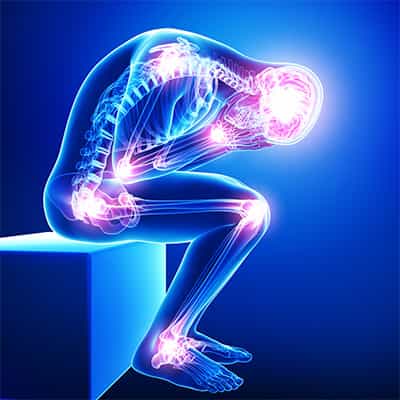
Fibromyalgia or Fibromyalgia Syndrome
Fibromyalgia or Fibromyalgia Syndrome
Last update: 28/02/2019, Dr. Miguel B. Royo Salvador, Medical Board number 10389. Neurosurgeon y Neurologist.
Definition
Fibromyalgia, or Fibromyalgia Syndrome, has an overall incidence in the population between 1% and 8% and mostly affects the female gender. The Fibromyalgia Syndrome is considered to be primary, or idiopathic, when it is not associated to any other condition; it is defined as secondary when its diagnosis is related to other clinical conditions (mainly chronic diseases).
In 1984 the pathological concept of Central Sensitivity Syndromes was introduced to include different processes with common characteristics, such as Fibromyalgia, Chronic Fatigue Syndrome and others.

Fig.1
Symptoms
Fibromyalgia is characterized by a chronic widespread musculoskeletal pain (in muscles and/or bones), associated to stiffness and extra-skeletal symptoms that affect different organs and systems. The most frequent among these symptoms are: bowel pain, headache, tachycardia, menstrual disorders, shortness of breath, insomnia, anxiety, low mood and depression, cognitive deficits in memory, attention and concentration. It is also defined by intense tiredness and easy fatigability.
Causes
To date there are no recognized specific causes for Fibromyalgia. As far as research is concerned:
- Recent studies support the theory that many signs and symptoms of Fibromyalgia may be due to a Central Nervous System dysfunction, which generates an altered processing of sensory stimuli.
- Likewise, current studies support a strong correlation between Fibromyalgia and Central Nervous System diseases.
- In particular, there are many evidences of neuroendocrine and autonomic system deterioration in the Fibromyalgia Syndrome, with very similar symptoms to those shown in a high percentage by patients with a Filum Disease diagnosis. This led other authors to believe that, at least in a limited subset of patients, Fibromyalgia may be considered an epiphenomenon of Filum Disease.
-According to the Filum System® health method:
In this last case, we observe that in some cases Fibromyalgia may be due a congenital mechanism of growth asynchrony, in the embryonic stage, between the spinal cord and the central nervous system on one hand and the spine on the other. This generates an abnormal spinal cord traction that is transmitted through an overly short and tense filum terminale, from the coccyx up to the cranium. Therefore we consider that the abnormal traction exerted by the Filum terminale can be a predisposing cause for the development of the Fibromyalgia Syndrome.
Diagnosis
Fibromyalgia symptoms tend to appear and disappear cyclically. This, together with the lack of knowledge on the specific tests required to detect it, make its diagnosis difficult, with the consequent delay in the application of treatments, even conservative ones.
In 1990, the American College of Rheumatology established the diagnostic criteria for Fibromyalgia Syndrome currently accepted. In 2010 they introduced new criteria that are pending validation.
In Fibromyalgia, non-specific alterations have been observed in functional Nuclear Magnetic Resonance and corresponding to other clinical pictures of chronic pain, such as: change in the volume of grey and white matter, in N-acetylaspartate, choline or glutamate levels, mainly in the hippocampus, insula, prefrontal and cingulate cortex.
Given the observed correspondence between several cases of Fibromyalgia and the Filum Disease diagnosis, the Filum System® recommends to proceed to a brain and full spine Nuclear Magnetic Resonance. This way, the presence of signs of an abnormal traction of the spinal cord can be tested as a possible alteration, visible through neuroimaging, of the Fibromyalgia Syndrome.
Risk factors
The main risk factors predisposing to the development of Fibromyalgia are:
- Female gender: the condition is more frequent in the female gender (the female/male ratio is 6/1).
- Age: the Fibromyalgia Syndrome can affect at any age, but it has been observed that its incidence increases with age.
- Genetic factors/Family history: the development of Fibromyalgia seems to be more frequent when it affects family members. Likewise, the Filum Disease, caused by the caudal traction exerted by an overly tense Filum Terminale, is a congenital condition that can be inherited between family members.
- Stress: physical or mental stress have been proven to be a possible trigger factor for Fibromyalgia.
- Other factors: in several cases, bacterial or viral infections, accidents or other conditions (like rheumatoid arthritis or lupus) have been identified as triggering agents, which do not seem to cause Fibromyalgia, but prompt the abnormal response that characterizes the disease.
Complications
- Deterioration of the Quality of Life: the symptoms of generalized pain and chronic fatigue in Fibromyalgia can increase or diminish cyclically. The symptoms of cognitive dysfunction can combine with the chronic pain ones in a vicious circle, generating depression and/or anxiety.
All this contributes into the deterioration of the quality of life of patients, who find themselves limited by the symptomatology in their regular activities and frustrated by the lack of understanding of their condition. The difficulty in detecting the disease can exacerbate its manifestations. - Chronic pain: the symptoms of the disease, among which we can find pain in muscles and bones, headaches, bowel pain and generalized pain, can become recurrent or chronic, further worsening the patients’ conditions.
Treatments
This condition does not have a definitive cure. To date, its treatment is performed in order to palliate pain, treat some other symptoms and obtain an improvement in the patients’ quality of life. The treatment of Fibromyalgia Syndrome today involves several specialties: internal and general medicine, rheumatology, rehabilitation, physiotherapy, psychology, dietetics etc.
As far as our specialty – Neurosurgery – is concerned, with the 2015 study published by Dr. Mantia and his collaborators, and based on the application of the Filum System®, they confirmed that the surgical approach applied to Fibromyalgia before physical therapy can improve the patient’s conditions. This may happen once the existence of signs of Filum Disease has been previously confirmed, as etiologically corresponding to the syndrome in at least a subset of cases.
Since 1993, with the publication of Dr Royo-Salvador’s doctoral thesis, which links the caudal traction of the entire nervous system due to the filum terminale to being the cause of several conditions, a new treatment has been designed. It is in this case etiological (cause-related) since the caudal cord traction force responsible for the pathological mechanism is eliminated by surgically sectioning the filum terminale.
Our technique for the sectioning of the Filum terminale (SFT) is minimally invasive and it is usually indicated as soon as possible in all cases, from mildly to severely symptomatic, as its risks are minimal, and it stops the condition’s progression.
The Sectioning of the Filum Terminale
Outcomes
Patients with Fibromyalgia who underwent the surgical sectioning of the Filum Terminale according to the Filum System® method, followed by rehabilitation, showed significant improvements compared to patients treated exclusively with physical therapy.
After physical therapy, patients who underwent surgery experienced a great improvement of symptoms in terms of reduced pain and better quality of life.
References
- Cazzola M, Sarzi Puttini P, Stisi S, Di Franco M, Bazzichi L, Carignola R, Gracely RH, Salaffi F, Marinangeli F, Torta R, Giamberardino MA, Buskila D, Spath M, Biasi G, Cassisi G, Casale R, Altomonte L, Arioli G, Alciati A, Marsico A, Ceccherelli F, Leardini G, Gorla R, Atzeni F, Italian Fibromyalgia Network (2008) Fibromyalgia syndrome: definition and diagnostic aspects. Reumatismo 60(Suppl.1):3-14.
- Claw DJ (2009) Fibromyalgia: an overview. Am. J. Med 122:S3-S13.
- Crofford LJ (1998) Neuroendocrine abnormalities in fibromyalgia and related disorders. Am J Med Sci 315:359-366
- Demitrack M, Crofford L (1998) Evidence for and pathophyiologic implication of hypothalamic-pituitary-adrenal axis dysregulation in fibromyalgia and chronic fatigue syndrome. Ann N Y Acad Sci 840:684-697
- Forseth KO, Gran JT, Husby G (1997) A population study of the incidence of fibromyalgia among women aged 26-55 yr. Brit J Rheumatol 36:1318-1323.
- Goldenberg DL (2009) Diagnosis and differential diagnosis of Fybromialgia. Am J Med 122:S14-21.
- Yunus MB (2008) Central Sensitivity syndromes: a new paradigm and group nosology for fibromyalgia and overlappiung conditions, and the related issue of disease versus illness. Semin Arthritis Reum 37:339-352.
- Kwiatek R, Barnden L, Tedman R, Jarrett R, Chew J, Rowe C, Pile K (2000) Regional cerebral blood flow in fibromyalgia: single-photon-emission computed tomography evidence of reduction in the pontine tegmentum and thalami. Arthritis Rheum 43:2823-2233.
- Mantia R., Di Gesù M., Vetro A., Mantia F., Palma S., Iovane A. Shortness of filum terminale represents an anatomical specific feature in fibromyalgia: a nuclear magnetic resonance and clinical study. Muscles Ligaments Tendons J. 2015 Mar 27;5(1):33-7.
- Mountz JM, Bradley LA, Modell JG, Alexander RW, Triana-Alexander M, Aaron LA, Stewart KE, Alarcón GS, Mountz JD (1995) Fibromyalgia in women. Abnormalities in regional cerebral blood flow in the thalamus and caudate nucleus are associated with low pain thresholds. Arthritis Rheum 38:926.
- Murga I et al. Cambios en la resonancia cerebral asociados al syndrome de fibromialgia. Med Clin (Barc). 2017.
- Royo Salvador M.B. (1996), Siringomielia, escoliosis y malformación de Arnold-Chiari idiopáticas, etiología común (PDF).REV NEUROL (Barc); 24 (132): 937-959.
- Royo Salvador M.B. (1996), Platibasia, impresión basilar, retroceso odontoideo y kinking del tronco cerebral, etiología común con la siringomielia, escoliosis y malformación de Arnold-Chiari idiopáticas (PDF). REV NEUROL (Barc); 24 (134): 1241-1250
- Dr. Miguel B. Royo Salvador (1997), Nuevo tratamiento quirúrgico para la siringomielia, la escoliosis, la malformación de Arnold-Chiari, el kinking del tronco cerebral, el retroceso odontoideo, la impresión basilar y la platibasia idiopáticas (PDF). REV NEUROL; 25 (140): 523-530
- M. B. Royo-Salvador, J. Solé-Llenas, J. M. Doménech, and R. González-Adrio, (2005) “Results of the section of the filum terminale in 20 patients with syringomyelia, scoliosis and Chiari malformation“.(PDF). Acta Neurochir (Wien) 147: 515–523.
- M. B. Royo-Salvador (2014), “Filum System® Bibliography” (PDF).
- M. B. Royo-Salvador (2014), “Filum System® Guía Breve”.
- Staud R (2008) Autonomic dysfunction in fibromyalgia syndrome: postural orthostatic tachycardia. Curr Rheumatol Rep 10:463-466.
- Tanriverdi F, Karaca Z, Unluhizarci K, Kelestimur F (2007) The hypothalamo-pituitary-adrenal axis in chronic fatigue syndrome and fibromyalgia syndrome. Stress 10:13-25.
- Winfield JB (2007) Fibromyalgia and related central sensitivity syndromes: twenty-five years of progress. Semin Arthritis Rheum 36:335-338.
- Wolfe F, Smythe HA, Yunus MB, Bennet RM, Bombardier C, Goldenberg DL et al. The American College of Rheumatology 1990 Criteria for the Classification of Fibromyalgia. Arthritis Rheum. 1990;33:160-72.


















